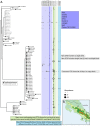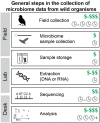Evolutionary Biology Needs Wild Microbiomes
- PMID: 28487687
- PMCID: PMC5404107
- DOI: 10.3389/fmicb.2017.00725
Evolutionary Biology Needs Wild Microbiomes
Abstract
The microbiome is a vital component to the evolution of a host and much of what we know about the microbiome derives from studies on humans and captive animals. But captivity alters the microbiome and mammals have unique biological adaptations that affect their microbiomes (e.g., milk). Birds represent over 30% of known tetrapod diversity and possess their own suite of adaptations relevant to the microbiome. In a previous study, we showed that 59 species of birds displayed immense variation in their microbiomes and host (bird) taxonomy and ecology were most correlated with the gut microbiome. In this Frontiers Focused Review, I put those results in a broader context by discussing how collecting and analyzing wild microbiomes contributes to the main goals of evolutionary biology and the specific ways that birds are unique microbial hosts. Finally, I outline some of the methodological considerations for adding microbiome sampling to the research of wild animals and urge researchers to do so. To truly understand the evolution of a host, we need to understand the millions of microorganisms that inhabit it as well: evolutionary biology needs wild microbiomes.
Keywords: evolution; field biology; gut microbiome; host-associated microbiota; ornithology.
Figures



Similar articles
-
Large Comparative Analyses of Primate Body Site Microbiomes Indicate that the Oral Microbiome Is Unique among All Body Sites and Conserved among Nonhuman Primates.Microbiol Spectr. 2022 Jun 29;10(3):e0164321. doi: 10.1128/spectrum.01643-21. Epub 2022 May 19. Microbiol Spectr. 2022. PMID: 35587638 Free PMC article.
-
Comparative Analyses of Vertebrate Gut Microbiomes Reveal Convergence between Birds and Bats.mBio. 2020 Jan 7;11(1):e02901-19. doi: 10.1128/mBio.02901-19. mBio. 2020. PMID: 31911491 Free PMC article.
-
Interpopulation Variation in the Atlantic Salmon Microbiome Reflects Environmental and Genetic Diversity.Appl Environ Microbiol. 2018 Aug 1;84(16):e00691-18. doi: 10.1128/AEM.00691-18. Print 2018 Aug 15. Appl Environ Microbiol. 2018. PMID: 29915104 Free PMC article.
-
Microbiome evolution along divergent branches of the vertebrate tree of life: what is known and unknown.Mol Ecol. 2016 Aug;25(16):3776-800. doi: 10.1111/mec.13730. Epub 2016 Jul 29. Mol Ecol. 2016. PMID: 27297628 Review.
-
Possibilities and limits for using the gut microbiome to improve captive animal health.Anim Microbiome. 2021 Dec 29;3(1):89. doi: 10.1186/s42523-021-00155-8. Anim Microbiome. 2021. PMID: 34965885 Free PMC article. Review.
Cited by
-
Vertically transmitted microbiome protects eggs from fungal infection and egg failure.Anim Microbiome. 2021 Jun 16;3(1):43. doi: 10.1186/s42523-021-00104-5. Anim Microbiome. 2021. PMID: 34134779 Free PMC article.
-
How longitudinal data can contribute to our understanding of host genetic effects on the gut microbiome.Gut Microbes. 2023 Jan-Dec;15(1):2178797. doi: 10.1080/19490976.2023.2178797. Gut Microbes. 2023. PMID: 36794811 Free PMC article.
-
Towards an Integrative, Eco-Evolutionary Understanding of Ecological Novelty: Studying and Communicating Interlinked Effects of Global Change.Bioscience. 2019 Nov 1;69(11):888-899. doi: 10.1093/biosci/biz095. Epub 2019 Sep 18. Bioscience. 2019. PMID: 31719711 Free PMC article.
-
Comparing western (Megascops kennicottii) and whiskered (M. trichopsis) screech-owl microbiomes in southern Arizona using a novel 16S rRNA sequencing method.Anim Microbiome. 2022 Jul 30;4(1):45. doi: 10.1186/s42523-022-00196-7. Anim Microbiome. 2022. PMID: 35908068 Free PMC article.
-
Ecological Dynamics and Microbial Treatments against Oomycete Plant Pathogens.Plants (Basel). 2021 Dec 8;10(12):2697. doi: 10.3390/plants10122697. Plants (Basel). 2021. PMID: 34961168 Free PMC article. Review.
References
Publication types
LinkOut - more resources
Full Text Sources
Other Literature Sources

